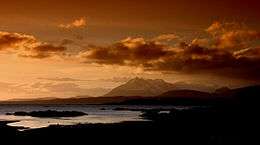Jon Schueler
| Jon Schueler | |
|---|---|
 | |
| Born |
September 12, 1916 Milwaukee, Wisconsin |
| Died |
August 5, 1992 (aged 75) New York City |
| Known for | Painter |
| Movement | Abstract expressionism |
Jon Schueler (September 12, 1916 – August 5, 1992), was an American painter.
Early life
Schueler originally wanted to become a writer and, after acquiring his MA at the University of Wisconsin–Madison in 1940, he worked for a short time as a journalist. The Second World War interrupted his writing. From 1941 to 1944 he served as an Army Air Corps navigator and flew numerous missions in a B-17 Flying Fortress bomber out of Molesworth, England, over France and Germany.
After the war, he moved to San Francisco and taught English while he began attending the California School of Fine Arts where he studied with Edward Corbett,[1] David Park, Hassel Smith, and Richard Diebenkorn. He chose Abstract Expressionism as his preferred style and moved to New York in 1951, where he became part of the New York School of artists. His first solo exhibition was in 1954, at the Stable Gallery.
Jon Schueler is represent by Ingleby Gallery worldwide.
Developing his style
First experiences of Scotland
In September 1957, he set up a studio just north of Mallaig, Scotland. He later described the effect this had on his painting:
"There now have been three massive experiences I have had with the Scottish sky. The first, in March 1958, when I had given up and, aching in my head and eyes and soul, I cycled from Mallaig Vaig to the white sands of Arisaig, where I watched the snow clouds moving toward me, implacable, from the sea. One passed over and through me, snow beating against my face. Then I turned to the south and saw the winter sun glowing in the snow cloud; strange image of light burning and dying through the shadows of a changing form. Though the sun was a winter sun, it translated itself in my mind to the most powerful and vibrant colors, reds, yellows, Indian yellows, or sometimes alizarin through blue."
After his first stay, from 1958 to 1959, he wanted to return to Mallaig, but various circumstances permitted only a few brief visits until 1970, when he settled there for almost five years. Meanwhile, he had painted in New York, and Chester, Connecticut, exhibiting in both solo and group shows, and teaching as a visiting artist at both Yale University and the Maryland Institute of Fine and Applied Arts, (now the Maryland Institute College of Art).
On a visit to Mallaig in 1967, he had another experience of the Scottish sky that became a major theme in his future repertoire:
"The second experience was in 1967 when I was at sea with Jim Manson, the day of the gale. A mist hung like a curtain, to the sea, haunted by a subtle glow from the direction of Rhum. I pointed out the image to Jim, who said, "Yes, we call that a sun dog; it's the sign of the gale." This warning of the storm that was to drive us from the sea was the most delicate sign, impossible to draw, impossible to define, impossible to understand except in the most exquisitely sensitive terms."
The summer of 1967 was also the first time he had begun to use watercolor as a medium, abandoning the use of heavy impasto that had characterized his earlier oil paintings.
Return to Scotland
Before 1970, his times in Scotland had been in the autumn, winter, and early spring, with a brief visit in the high summer. Though he had experienced the very short winter days of the far north, he had yet to see the midnight sun of a June night. When he did, he had what he describes as an intense revelation:

"Last night I had one of the very important visual experiences of my life. It was late, 11:30, when I looked out the studio window and was struck by the somberness of what I was able to see...I went out...The vision was intensely real, yet it was the most powerful abstraction...this vision of death, or of Nature beyond life, or of Nature as she must exist beyond that fantasy of life that we imagine...This abstraction of the sea and the sky and Sleat – I was possessed by it, wanted to walk into it, to disappear into it. I was exhausted afterward. There was no color I could define: The greys were not grey, the silver was not silver, the blacks were not black. It was all light and all darkness. Believe me, I have seen eternity, and it is frightening and it is most beautiful, more beautiful and more powerful than any man or any woman or the works of either..."
Horizontal lines had been a part of his compositions for some years. After this experience, he concentrated on developing this theme further, producing many paintings in which the picture surface is meant to "vibrate" with bands of color that depend on the effects of light during the changing seasons on the Sound of Sleat. This would remain the central element of his style for the next three decades.
References
- ↑ "To The Director of The California School of Fine Arts", undated, Edward and Rosamond Walling Tirana Corbett Papers, 1932–1978, The Smithsonian Institution, American Archives of Art, Reel 4382.
Bibliography
- Jon Schueler: To the North, by Gerald Nordland and Richard Ingleby, Merrel Publishers(2002). ISBN 1-85894-177-6.
- American Abstract Expressionism of the 1950s An Illustrated Survey, by Marika Herskovic, New York School Press (2003) ISBN 0-9677994-1-4. pgs. 306-309